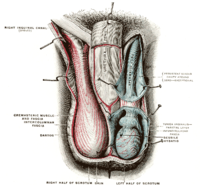
Photo from wikipedia
The aim of this study was to compare co-contraction index (CCI) computed from muscle moments to different co-activation indexes (Co-Act) derived from EMG data at the ankle and the knee… Click to show full abstract
The aim of this study was to compare co-contraction index (CCI) computed from muscle moments to different co-activation indexes (Co-Act) derived from EMG data at the ankle and the knee joint during gait. An EMG-driven model was used to estimate muscle moments during over-ground walking gait at a self-selected velocity from twelve healthy subjects. The CCI calculated from muscle moments was compared with three Co-Acts estimated from the normalized EMG data. The co-activation methods produced lower values than the CCI during the first double-support and the swing phase at the ankle joint and during the stance phase at the knee joint. The co-activation methods trend is to underestimate the simultaneous action of agonist and antagonist contraction. Because the EMG-driven model included the muscle mechanical properties (e.g. force-length-velocity relationship) and muscle moment-arm, the co-contraction based on major agonist and antagonist muscle moment may provide a more confident description of muscle action compared to co-activation indexes.
Journal Title: Journal of biomechanics
Year Published: 2017
Link to full text (if available)
Share on Social Media: Sign Up to like & get
recommendations!